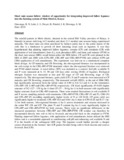| dc.description.abstract | The rainfall pattern in Molo district, situated in the central Rift Valley province of Kenya, is bimodal in nature with long (4-5 months) and short (2-3 months) rain seasons being experienced annually. The short rains are often unutilized by farmers partly due to the acidic nature of the soils that is a hindrance to growth of short maturing crops such
as legumes. It was thus hypothesized that planting improved fallow legumes; cowpea (CP) and crotalaria (CR) with application of soil amendments; lime (L), rock phosphate (RP), and farm yard manure (FYM) in the short rain season (SRS) would better utilize the SRS fallow. CP and CR were planted in the SRS of 2005 and 2006 with (CPL+RP, CRL+RP and CRL+RP+FYM) and without (CP0 and CR0) application of soil amendments. The experiment was laid out in a randomized complete block design. At CP maturity and CR flowering, the aboveground biomass was incorporated in the soil except in
the CRL+RP+FYM treatment where the aboveground biomass was removed and FYM added instead. A weed fallow (WF) was included as a control. Soil pH, available N and P were measured at 0, 15, 90 and 120 days after sowing (DAS) of legumes.
Biological nitrogen fixation was measured at late pod fill stage of CP and flowering stage of CR, respectively. The aboveground biomass, grain yield (CP), N and P contents were measured at CP maturity and CR flowering, respectively.
The measured soil pH (H2O), at the end of 2006 SRS, had significantly increased from the initial value of 4.94 to 6.0, 6.2 and 6.1 in the treatments; CPL+RP, CR L+RP and CRL+,RP+FYM, respectively. CR fixed significantly (P<0.05) higher amounts
of N2 (127 - 158 kg ha-1) than CP (37 – 56 kg ha-1) in both seasons with significantly higher amounts fixed in CRL+RP treatment. There were marked fluctuations in soil available N and P across sampling periods with treatments; CRL+RP+FYM,
CRL+RP (N and P), CR0 (N) and CPL+RP (P) recording significantly higher levels of N at 120 DAS. CP grain yield was significantly higher in treatment; CPL+RP (0.6 and 0.68 t ha-1) than in CP0 (0.20 and 0.17 t ha-1) for both seasons.
Aboveground biomass (t ha-1) across treatments and seasons increased in the order WF, CR and CP. The plant N and P content (kg ha-1) were significantly higher in CPL+RP and CRL+RP+FYM for both seasons. There were no significant differences in the measured parameters between CRL+RP and CRL+RP+FYM. CR residue can therefore be incorporated directly into soil or fed to livestock and recycled back to the cropland as FYM. Planting improved fallow legumes, with application of soil amendments, better utilized the SRS fallow and is a sustainable approach to ameliorating soil pH and enhancing soil available N and P to the benefit of the subsequent LRS crop. The legumes would further provide a cheaper source of protein in the farmers’ diet (CP grains) besides being sold to fetch income and used as livestock feed (CR). | en |

